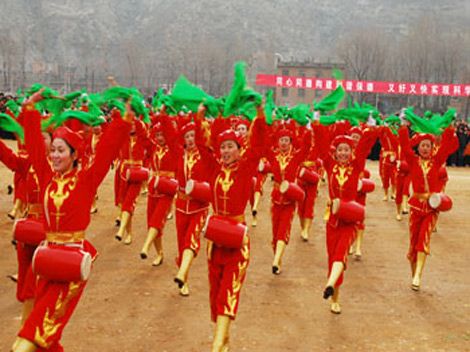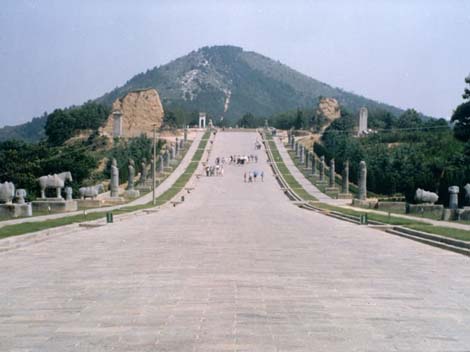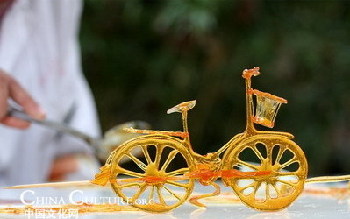| Home > China Feature |
A Brief History of Ancient China
China is the world's oldest surviving nation. It is well over 4000 years old and shows no sign of leaving. Sometimes studying its history can be a long and confusing path. With each emperor and each dynasty it only seems to get more complicated. It is also hard to mark its beginning. Some say it started with the Hsia dynasty. Others claim that people had an organized society before them.
The Predynastic Regime- c. 10,000-2,100 BCE
Many men ruled China before dynasties came. They basically set the entire standard for all of organized civilization. During this period, the Chinese created the building blocks of dynasties to come, including families, agriculture, boats, silk, carts, and calendars. The last of these rulers was named Yu. When he died, everyone chose his son to rule, thus setting the standard for hereditary rule. This is recognized as the first dynasty, the Hsia.
Hsia Dynasty- c. 2,100-1,600 BCE-
Some people claim the success of the Hsia dynasty was based on the technologies of the Bronze Age. In certain ways, they are correct, because many people in northern China were very skilled in the art of bronze working. This craft united the fledgling culture of the Neolithic peoples and created a mighty nation. The success of this civilization is shown by the many technologies developed during the era. These included writing, the domestication of horses, a class system, and a stable political and religious hierarchy. The Hsia were overthrown by an unnamed rebel leader who founded the Shang dynasty.
Shang Dynasty- c. 1600-1046 BCE-
In the Shang perspective, the King was the keeper of the religious "status-quo", and his subjects believed that he could foresee the future when examining the cracks in animal bones. The Shang were a war-like people who constantly waged bloody conflict with all those around them. In fact, they had to move their capitol several times, to protect from enemy attack. The Shang king had the authority to construct and order massive armies for warfare and construction projects. The Shang dominated the land in what is now central China, and its successful military campaigns brought even more land under its control. But the Shang apparently picked one enemy too many. A bordering state, the Zhou, declared an all out war on the Shang. Weakened by other costly wars, the crumbling Shang were no match for the Zhou. In c. 1046
BCE, the Shang were crushed. A new dynasty had grabbed hold of China.
Zhou Dynasty- c. 1046-256 BCE-
The Zhou kings were very similar to those of the Shang dynasty. They were keepers of the religious status-quo, and their subjects believed that they had mystical powers. They also worshipped their ancestors. The Zhou dynasty was a time in China where family values were the most important focus in life.
Early Zhou rulers didn't force direct control on their peoples. Instead, they chose only their most loyal supporters to run small territories, and pay a tax to the king for the privilege of power. These people became some of China's first nobles. Each territory's control was passed down from son to son, creating in time a hereditary vassal state. In time, the King's power over the states declined, and the states began to war with each other. Eventually the Zhou king's power evaporated completely, and eventually led to the warring states period.
The Warring States- 5th century-221 BCE-
When the Zhou powerbase collapsed, China was left with many warring states all competing for dominance of the country. Each state fought bloody civil wars against each other, and there seemed like there would be no winner, but then stepped in a new country called Qin. It was part of the Qin religion to conquer all of China. They believed that their king was destined to "rule everything under heaven". The Qin soon launched an all out offensive to conquer of all China. Due to two advantages, iron weapons and chariots, the Qin were able to make an easy victory. This thus created the Qin dynasty.
Qin Dynasty- 221-206 BCE-
The Qin dynasty had only one emperor, the evil and tyrannical Shi Huangdi. During the wars of unification, Huangdi is described as a fair king and a great general. But after the unification, he became paranoid, and cruel. Many believe he went insane. He increasingly looked for assassins everywhere he went. He was the first person to force his people built the great wall, to guard him from his enemies. In 206 BCE he died under mysterious circumstances. Some say he died of mercury poisoning. Others claim he was murdered by an assassin. Whatever the cause, immediately after his death, one of Huangdi's generals mobilized and took control of the government. This created the Han dynasty.
Han Dynasty- 206 BCE-220 AD
The Han dynasty was created when the general Liu Bang seized the throne in a coup. The Han steeply reduced taxes, repealed useless and burdensome laws, and brought stability back to the empire. But the biggest difference between the Qin and the Han was who they appointed as leaders. The Han's leaders and advisors were elected based on Confucian virtues, instead of being appointed for his connections. But perhaps the greatest accomplishment of the Han was to be the first Chinese peoples to write their history down. But around 200 AD, the Hans's power was waning. At this time internal disintegration began to overshadow military success and, in 220 AD, the last Han emperor abdicated, leaving China divided into three different kingdoms. Only one thing was certain. China would never be as powerful as it was \during its peak at the Han dynasty.
The Chinese empire was built on the backs of its peasants. Their ability to endure hardship was unimaginable. The Chinese have pushed their civilization to triumph again and again, and they show no intention of stopping. In 1949, the Chinese peasants struck back against its government. The Chinese reds pushed their oppressors out of China and created from the ashes a new empire, Communist China.
Art
 more
moreYicheng Hua Gu
The Flower Drum 花鼓 of southern Shanxi Province is a kind of folk d...

Sculpture in Qianling Mausoleum
The sculpture of Qianling Mausoleum is the main relic of the ground ...

A Sweet Art:Sugar Painting
In and around China’s southwestern Sichuan Province, it is usual to ...

Custom
 more
moreWeb Dictionary
Martial Arts
Wuxia, a Popular Culture for Most Chinese-Speaki...
Wuxia (武侠) is a broad genre of Chinese fiction that concerns its...
“Chinese Kung Fu Hot”
“Part the Wild Horse’s Maneton Both Sides”, “White Crane Spreads Its...
“Chinese Kung Fu Hot” in Alfred University
“Part the Wild Horse’s Maneton Both Sides”, “White Crane Spreads Its...





 print
print  email
email  Favorite
Favorite  Transtlate
Transtlate 







